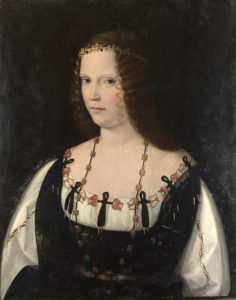Lucrezia Borgia (1480 – 1519) was a member of one of the most infamous families of the early modern period. The Borgia name is synonymous with poison, murder, and incest. While a great deal of the family’s reputation is earned, a lot of it is myth, spread by contemporaries who despised and feared the Borgias.
Lucrezia was born in 1480 near Rome, the daughter of Rodrigo Borgia (the future Pope Alexander VI) and one of his favourite mistresses, Vanozza dei Cattanei. She had three brothers: Cesare, Giovanni, and Gioffre. As the only girl, she was cherished and spoiled by her family and was not part of the sibling rivalry of her older brothers, Cesare and Giovanni. She was given an impressive education, more expansive than other women of her generation, which included humanities, extensive languages, music, poetry and oration.
She married three times, all for the advancement and strategic alliances of her family. Her first marriage to Giovanni Sforza in 1493 made an alliance with the Sforza family, Lord Pesaro and Count of Catignola. Problems began when her father felt there was no longer a need for this connection and thus Lucrezia’s marriage was now expendable. It is widely believed that her father planned to have him murdered, but when Cesare told Lucrezia, she warned her husband and he fled from Rome. Her father then tried to get the marriage annulled by offering Giovanni Sforza Lucrezia’s dowry to agree to the annulment. At first he refused and accused his wife of parental incest, but after heavy pressure from his family he eventually signed the annulment saying the marriage was never consummated because he was impotent. It is probable that this where the incest myth began.
Her next marriage was in 1498 to Alfonso, Duke of Bisceglie, the illegitimate son of Alfonso II of Naples. At the same time, her younger brother Gioffre married Alfonso’s half sister, Sancha of Aragon. These marriages were to strengthen Alexander’s connection with Naples. Soon after the marriage, Cesare formed an alliance with Louis XII of France, and began a campaign in the Romagna, which threatened Naples. Learning from his predecessor, Alfonso fled Rome. He was convinced to return to Rome with Lucrezia a few months later. However, the following year, he was attacked by four assassins in front of St Peter’s Basilica. While recovering from his injuries, he was strangled to death; it is widely believed that Cesare was behind both of these attacks.
Lucrezia’s third and final marriage was to Alfonso d’Este, son of Ercole I, Duke of Ferrara. The d’Este family initially declined this offer, put off by the repugnant rumours circling the Borgia family, but eventually they conceded and the pair married in 1501. The marriage would benefit Cesare in consolidating his position in the Romagna. The couple had many children together, and Lucrezia certainly had more freedom in Ferrara than she had in Rome.
The Borgia family has long been associated with many crimes and Lucrezia was thought to have been a willing accomplice — poisoning people to benefit her family’s schemes. While it is likely that the Borgia family (namely Alexander and Cesare) did commit many crimes, including murder, these have been exaggerated by the many enemies they made, particularly Italy’s other powerful families: the Medicis and Sforzas. Recent historians have looked more favorably onto Lucrezia believing her to have been a pawn rather than an accomplice for her family. Once her father died in 1503 and the family fortunes began to decline, she managed to avoid the fallout through her marriage, and out of the shadow of her family, she championed the arts during the Italian renaissance. She died at the age of 39 of childbirth complications.

